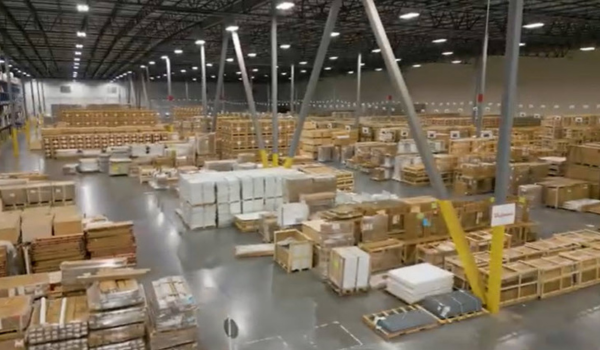If you rely on vendor-direct, just-in-time FF&E shipments for your store remodels, openings, and conversions, consolidating that FF&E might be a better strategy. Why? The short answer is that FF&E consolidation could dramatically improve your efficiency and save you significant money.
But is it for everyone? Not necessarily.
Let’s take a detailed look at the major pros and cons of FF&E consolidation with Phillip Walker, Director of Business Development for Store Opening Solutions and a retail logistics expert with 20+ years of experience.
(For more on the nuts and bolts of consolidation, be sure to check out Retail FF&E Consolidation: See How It Works and Why It’s a Better Process.)
The pros of FF&E consolidation: Control, efficiency, and cost-savings
1. Control your inventory for super-efficient store setups
With FF&E consolidation, you have a dedicated warehouse space with your consolidator. This enables you to order FF&E earlier in your process because you have a place to reliably store items. Now, with ALL needed FF&E for upcoming projects already warehoused, you can make store-specific orders not just conveniently but confidently.
That’s because you have a dedicated warehouse team inspecting, picking, and packing your orders. Plus, you can rely on logistics pros who make sure your order arrives right when it should. “Just-in-time orders from vendors don’t always do that,” says Walker, “and delays can have a costly ripple effect on your project and even throw off your entire schedule.”
Moreover, consolidation’s advantages can actually empower you to compress installer timelines, negotiate a shorter setup schedule, and ultimately pay for fewer installation hours.
2. Save big on transportation costs
Vendor-direct shipping involves using a multi-hub system of less-than-truckload (LTL) shipments. This is an expensive, inefficient way to move your freight because it requires more trucks on the road hauling smaller amounts of your freight.
On the other hand, FF&E consolidation maximizes the use of full truckload (FTL) shipments, a much more cost-effective option than LTL shipping. “It’s a cost-per-pallet savings that can add up surprisingly fast, especially for larger retailers,” says Walker.
How big of a deal is the full truckload factor? One major retailer saved $300,000 in transportation costs over the course of 105 store projects just by switching to an FF&E consolidation model.
3. Help your team work smarter (not harder)
“Managing scores of just-in-time, vendor-direct deliveries can be a logistical nightmare for your internal teams,” says Walker, and increasing your head count isn’t necessarily the best solution. Meanwhile, the clock is ticking.
But FF&E consolidation reduces the burden on your current staff. Your team doesn’t have to track—and in some cases—chase down multiple inbound shipments. Instead, they have a single point of origin and a single point of contact for all needed FF&E.
Then there’s the bigger picture: Your staff members are more efficient because they can focus on managing FF&E inventory levels, which is much easier than managing all those vendors. And the bonus is that they can now devote time to initiatives that were put on the backburner.
4. Buffer your operations from supply chain disruptions
How well did you handle the recent supply chain challenges, particularly for FF&E? And how prepared will you be when—not if—that pendulum swings back to more supply chain pain?
Since FF&E consolidation lets you order FF&E and store it for the future, that also means you can blunt the sting of longer lead times and potential schedule disruptions.
And with this approach, you can also build up a safety stock of FF&E, which can help keep you on track when the supply chain goes awry—and your competitors are scrambling. In addition, you can now be more strategic with your purchasing decisions, choosing to order or delay purchasing based on market conditions.
The cons of FF&E consolidation: New changes, expenses, and risks
1. Make major changes to your operations
FF&E consolidation involves changing how you manage FF&E inventory and store setups. For some retailers, sticking to the same old ways is a more attractive option than the time, effort, and expense it would take to modify well-worn FF&E operations.
All that said, you don’t necessarily have to dive into consolidation head first. Vines suggests testing out the waters to experience the process firsthand.
“If you have a smaller FF&E project with a finite delivery timeline and a smaller number of SKUs, like a reset or light refresh, you can plan to have items shipped to a consolidator’s warehouse.” (For more on that, check out How to Give FF&E Consolidation a Try Without Upending Your Current Operations.)
2. Add a new expense to your budget
While FF&E consolidation is often a cost-saving solution, it does introduce a new expense: the service and warehousing costs your consolidator charges.
You need to carefully weigh whether the savings and efficiencies you could gain offset the fees associated with consolidation. For some, especially those with tight budgets, the upfront costs might be difficult to justify, even if there are long-term savings to be had.
“But if you are seriously considering FF&E consolidation,” says Walker, “don’t make a decision without doing a thorough cost-benefit analysis.” For example, Store Opening Solutions offers a free FF&E program audit. We’ll crunch the actual numbers from your current program, and then clearly lay out what you could save by opting for FF&E consolidation.
3. Risk over-purchasing FF&E inventory
FF&E consolidation relies on a bulk purchasing model. This comes with a risk of overcommitment to stock and storage space, particularly if market conditions shift, retail expansion plans slow, or a specific SKU is discontinued. And no one wants capital sunk into resources that aren’t being utilized.
But it’s also worth noting that, regardless of your FF&E strategy, you may be forced to buy in bulk if a manufacturer requires a full-pallet order minimum (which has become more and more common).
Keep in mind that in slower times, excess stock can often be redirected to existing stores for updates, remodels, or refreshes. Additionally, having inventory on hand allows you to react quickly when the market picks back up, giving you a competitive edge over other retailers.
On top of that, inventory risks can be mitigated with expert support. A good consolidator can help you plan your inventory. For example, they can point out any SKU drop-offs so you can adjust future orders strategically and prevent over-ordering.
4. Won’t benefit small-scale operations
FF&E consolidation generally isn’t for small-scale retailers who open only a few stores a year. “A minimum of 50 to 100 store projects per year is a good rule of thumb,” says Walker.
If you are a smaller retailer, you likely have ample lead time to manage direct deliveries from multiple vendors, and the complexity of consolidating shipments for a handful of stores would likely mean unnecessary overhead.
But, if you should ever begin to expand more rapidly, Vines says that consolidation can ensure “you meet aggressive timelines without missing a beat.”

Find Out How Well FF&E Consolidation Could Work for You
Gaining control of your FF&E, saving time and money, reducing staff stress—advantages like these could transform how you implement your store projects. But do they outweigh the costs of FF&E consolidation?
Take the next step to find out. Whether you’re interested in our free FF&E program audit or want to try out consolidation with a smaller project, be sure to contact Store Opening Solutions today to start a discussion!
About Store Opening Solutions
We support the strategic vision of retail organizations with focused expertise in the consolidation and installation of store fixtures and equipment. Our dedicated team embraces your vision and partners with you to create appropriate inventory control processes.







